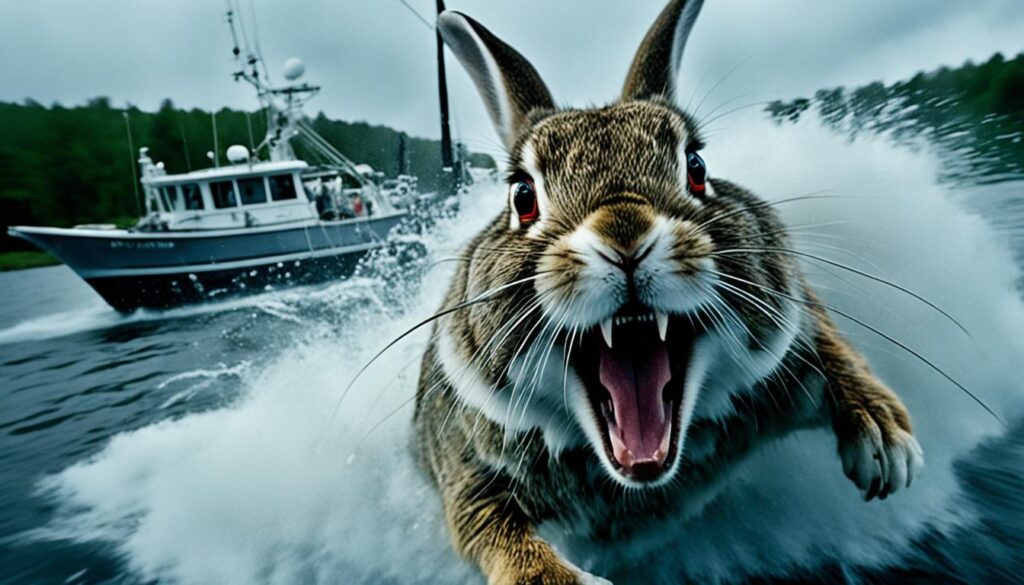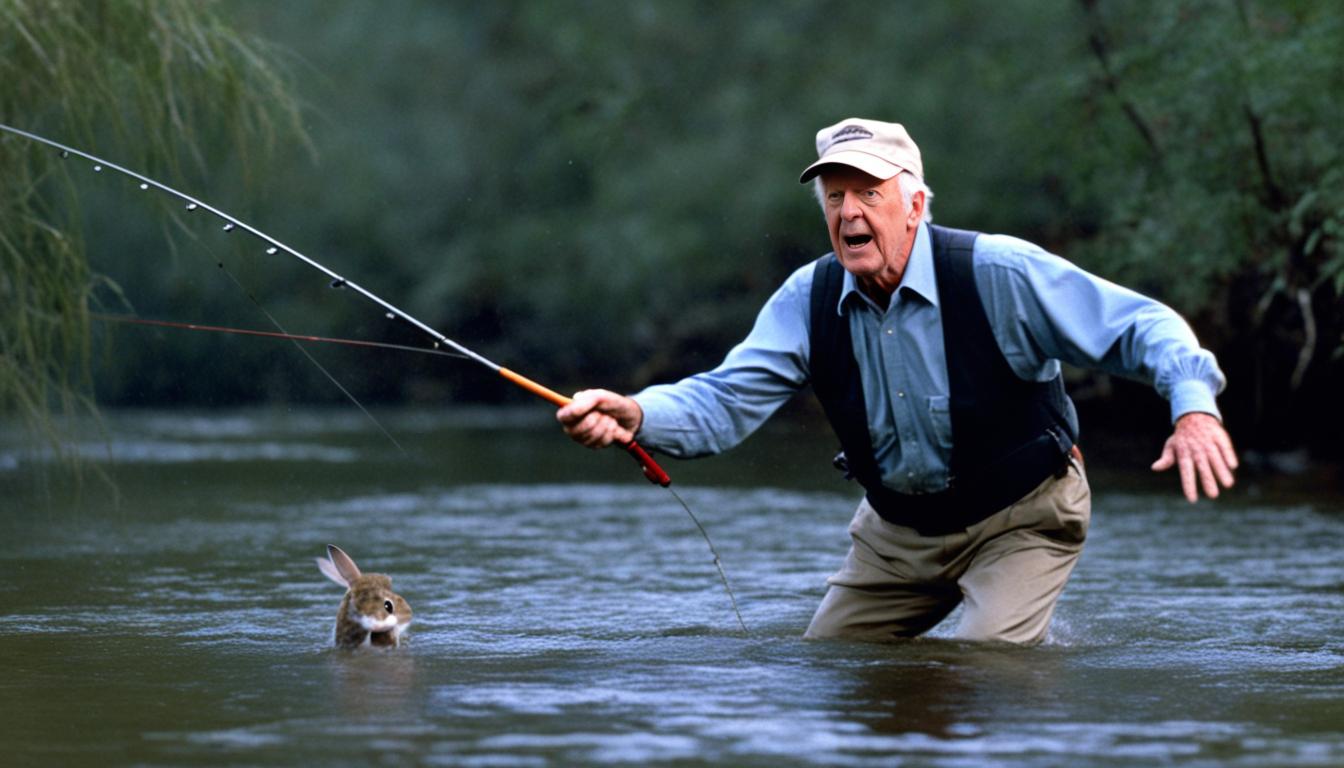On a quiet spring day in 1979, President Jimmy Carter found himself in an unexpected and peculiar situation while fishing in a pond on his farm in Plains, Georgia. As he cast his line and enjoyed the tranquil surroundings, a swamp rabbit suddenly emerged from the water and began swimming directly towards his boat. The rabbit, likely fleeing from a predator, was described as “hissing menacingly, its teeth flashing and nostrils flared” as it approached Carter’s boat.
In a moment of surprise and self-defense, Carter reacted by either hitting or splashing water at the rabbit with his paddle to scare it away. The swamp rabbit, seemingly undeterred by the president’s actions, continued its aggressive approach before eventually swimming away and climbing out of the pond. Unbeknownst to Carter at the time, a White House photographer captured the bizarre scene, although the rabbit was too small to identify in the initial photo.
The incident, which would later become known as the “Jimmy Carter rabbit incident” or the “killer rabbit attack,” left the president uninjured and the fate of the swamp rabbit unknown. This peculiar encounter between a sitting U.S. president and a seemingly aggressive aquatic animal would soon capture the attention of the media and the public, sparking a mix of amusement, disbelief, and satirical commentary.
Key Takeaways
- President Jimmy Carter encountered an aggressive swamp rabbit while fishing in Georgia in 1979
- Carter defended himself by hitting or splashing water at the rabbit with his paddle
- A White House photographer captured the incident, but the rabbit was initially too small to identify in the photo
- Carter was uninjured, and the fate of the swamp rabbit remains unknown
- The incident sparked media attention and public amusement, becoming known as the “Jimmy Carter rabbit incident” or “killer rabbit attack”
The Incident: President Carter’s Surprising Encounter with a Swamp Rabbit
In 1979, while fishing alone in a flat-bottomed boat on a pond near his hometown of Plains, Georgia, President Jimmy Carter had a surprising encounter with a swamp rabbit. As Carter cast his line, his staff remained on land nearby, unaware of the peculiar event that was about to unfold.
The incident began when a swamp rabbit, fleeing from hounds, plunged into the water and began swimming determinedly towards the President’s boat. As the rabbit approached, Carter initially remained calm, observing the animal’s unusual behavior. However, as the determined creature drew closer, the President grew concerned about the swamp rabbit’s intentions.
In an attempt to deter the advancing rabbit, Carter splashed water with a paddle, hoping to discourage the animal from approaching further. To the President’s relief, the swamp rabbit turned and swam away, leaving Carter to ponder the peculiar nature of the encounter.
When Carter shared the story with his staff, they were initially skeptical, finding it difficult to believe that a rabbit would swim or approach a person in such a threatening manner. The White House photographer, who had not captured the moment on film, also expressed doubt about the incident.
In response to the story, University of Maryland zoologist Vagn Flyger offered his insight into the swamp rabbit’s behavior. Flyger suggested that the rabbit was likely frightened and seeking a dry place to escape, rather than intentionally attacking the President. The zoologist’s perspective shed light on the possible motivation behind the rabbit’s unusual actions.
Carter’s Swamp Rabbit Incident: Media Coverage and Public Reaction
The press sensationalized the incident as a “killer rabbit attack,” and it caught the imagination of the media after Carter’s press secretary, Jody Powell, mentioned it to a correspondent months later. The story received front-page coverage in The Washington Post and The New York Times in August 1979, with headlines like “Bunny Goes Bugs: Rabbit Attacks President” and “A Tale of Carter and the ‘Killer Rabbit’.”

News cartoonists drew exaggerated illustrations of the event, as the White House initially refused to release the photograph. The media used the incident as a metaphor to negatively portray Carter, influencing public perception of him as the 1980 presidential campaign approached. The media sensationalization of the killer rabbit attack played a role in shaping public opinion about Carter’s leadership capabilities.
In the subsequent elections, Carter lost to Ronald Reagan, and Republicans gained a majority in the Senate for the first time since 1954. While the swamp rabbit incident was not the sole factor, it contributed to the overall media narrative and public perception of Carter’s presidency leading up to the 1980 presidential campaign.
The Photographic Evidence and Its Release
The now-famous encounter between President Jimmy Carter and a swamp rabbit was captured by a White House photograph, but the rabbit’s small size made it difficult to identify in the initial image. Despite the media’s keen interest in the story, the Carter administration was hesitant to release the photograph to the public. Deputy Press Secretary Rex Granum stated, “There are just certain stories about the president that must forever remain shrouded in mystery,” indicating the administration’s desire to keep the incident under wraps.
Press Secretary Jody Powell expressed concern that releasing the photo would shift the focus away from important matters, such as the SALT treaty, and instead place undue attention on the rabbit controversy. However, the photograph eventually found its way into the public sphere when the Reagan administration discovered a copy and released it to the press, reigniting media coverage of the incident.
Years later, Jerry Callen, a blogger, obtained a digital copy of the photograph from the Jimmy Carter Library and shared it on his blog, Narsil.org. The release of the image provided visual confirmation of the encounter and further solidified the incident’s place in presidential history. The photograph’s journey from the White House to the Jimmy Carter Library and eventually to the public domain demonstrates the enduring political impact and media coverage surrounding this memorable moment in Carter’s presidency.
The Legacy of the Carter Rabbit Incident
The Carter rabbit incident has become a part of American political satire and folklore, often referenced in various forms of media and popular culture. The event and the reactions to it were parodied in multiple xkcd comics and a Saturday Night Live sketch, solidifying its place in the annals of bizarre presidential moments. This incident has been compared to other embarrassing or unusual events involving U.S. presidents, such as George H. W. Bush’s vomiting incident and George W. Bush’s shoe-throwing incident, highlighting the scrutiny and attention that come with the highest office in the land.
Despite the humorous nature of the event, it had a lasting impact on public perception of Jimmy Carter’s legacy and his presidency, demonstrating the power of media narratives in shaping political opinions. The incident showcased how even seemingly minor events can have significant consequences in the political arena, as the media’s portrayal of the event contributed to the perception of Carter as a weak and ineffectual leader. This event serves as a reminder of the complex and often contentious relationship between media and politics, and how public figures must navigate this landscape carefully.
The legacy of the Carter rabbit incident extends beyond its immediate impact on his presidency, as it has become a cultural reference point and a symbol of the unexpected challenges that leaders may face. It also highlights the role of humor and satire in political discourse, as the incident has been used to both criticize and humanize political figures. Ultimately, the Carter rabbit incident remains a fascinating chapter in American political history, one that continues to be discussed and analyzed for its implications on the relationship between politicians, the media, and the public.

Leave a Reply